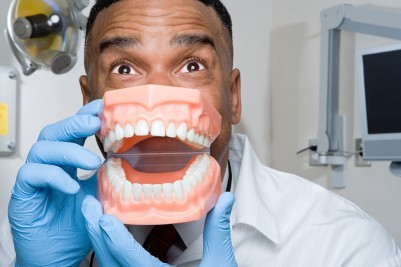Signs that it’s time to see a dentist
 Something just isn’t right with your mouth. Maybe you are experiencing dull, constant pain yet can’t really identify its source. Maybe you have some odd, uncomfortable anomaly that is becoming more and more concerning. Or, perhaps a specific tooth is really causing you great pain and it’s affecting your mood, energy level, sleep and your overall sense of wellbeing.
Something just isn’t right with your mouth. Maybe you are experiencing dull, constant pain yet can’t really identify its source. Maybe you have some odd, uncomfortable anomaly that is becoming more and more concerning. Or, perhaps a specific tooth is really causing you great pain and it’s affecting your mood, energy level, sleep and your overall sense of wellbeing.
There are a myriad of symptoms and signs that are telling you it’s time to go see a dentist. In some cases, these signs are screaming. What do you do in this case?
Do you immediately call your dentist and schedule an appointment? Or do you go day after day thinking that it will somehow subside and just go away?
Or, taken one step further, do you disregard it as if it’s not really a problem? Chance are you’re very wrong. And so, for those of you who recognize that good oral health and hygiene is vital to good overall health and well-being, here are some signs that you need to get to a dentist.
Pain, redness in the gums, an unfavorable taste in your mouth, a fever, and swelling
These are signs of an abscessed tooth which essentially is an infection resulting from a decayed tooth, a tooth that is cracked, or periodontal disease. If you have this problem, bacteria could be allowed to enter the tooth’s’ soft tissue; this tissue contains connective tissue, blood vessels, and nerves and can ultimately cause the death of the pulp.
This is not a pleasant circumstance. Pus accumulates at the jaw bone’s root tip and forms an abscess. Also described as a pus-pocket, the untreated abscess can prompt a grave infection in your teeth, surrounding tissues, and your jawbone.
If you go to a dentist upon first experiencing any of the above signs, your abscess can be treated based upon how severe it has become. Treatment may be as simple as taking antibiotics so the bacteria responsible for your infection is destroyed. Other treatment methods include draining the infection, root canal treatment (associated with a cracked tooth causing the abscess), or if it’s caused by gum disease, the space between the gum and your tooth can be cleaned.
If you would li to bypass an abscessed tooth altogether (and who wouldn’t, right?) practice good oral hygiene and visit your dentist routinely.
Easily bleeding gums, bad breath, swollen, red, tender gums
These are signs of gum disease in its early stage, which is gingivitis, also referred to as a periodontal disease. This is another type of infection; in this case, it is the tissues surrounding your teeth. With plaque buildup as the culprit, the above signs and symptoms indicate you have this type of infection.
This plaque buildup occurs for a variety of reasons. Among them are smoking or using tobacco; genetics; teeth that are difficult to clean because they are crooked; medications – steroids among them; select kinds of anti-epilepsy medications; cancer therapy drugs; certain oral contraceptives; certain calcium blockers.
This condition can be reversed. The infection can be eradicated. But you must go to your dentist upon experiencing any of the above signs or symptoms. For more information regarding anything related to your oral health, give Dr. Apsey of Smile Brightly Dental a call today! We are located in Warren, MI and we can be reached at 586-573-7700!
